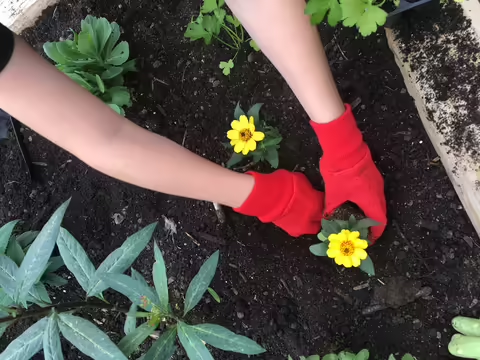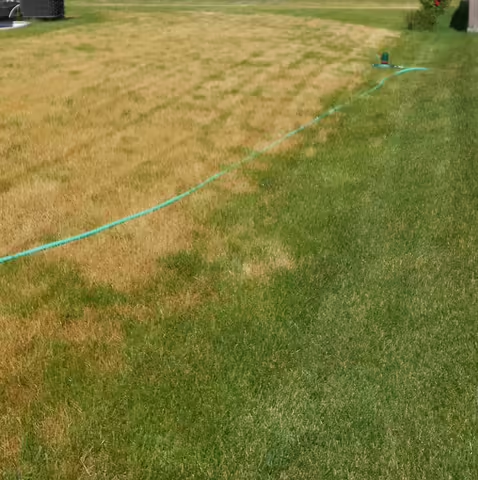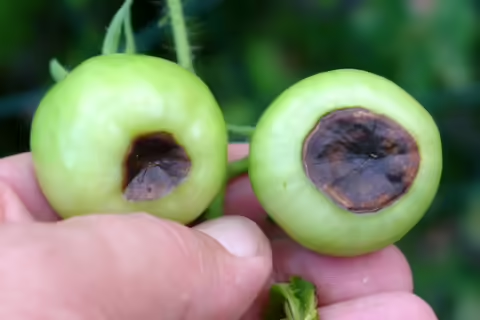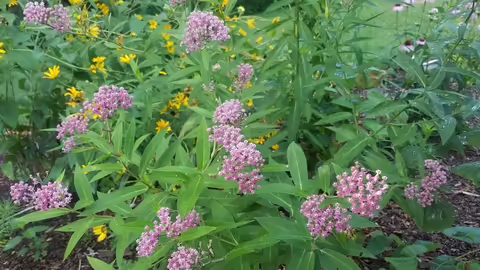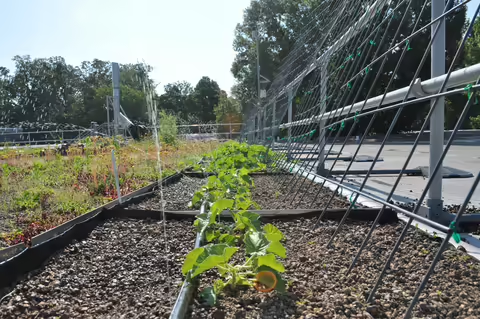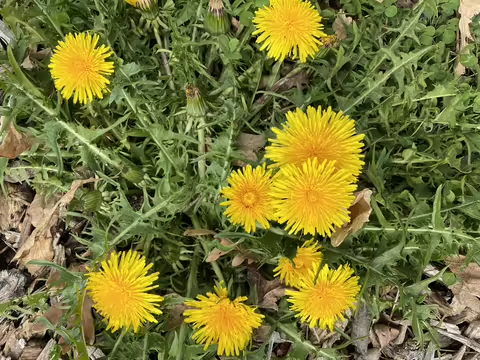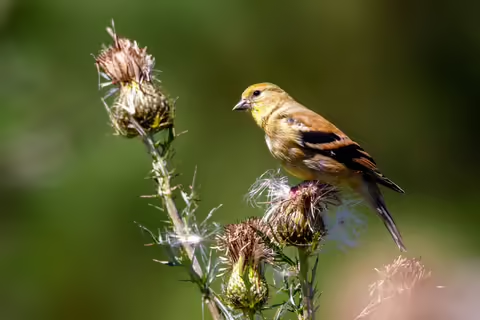School gardens offer numerous benefits beyond beautification
By Brittnay Haag, horticulture educator
Even with the best teachers and best technology, sometimes the best learning happens in the garden. Many school grounds have gardens for visual reasons, but the benefits of having flowers, herbs, vegetables, and fruit trees go far beyond beautification.
While so much emphasis put on the use of technology in the classroom, many kids today are missing out on the experience right outside the school doors.
School gardens create hands-on learning opportunities for students that aren’t typically found in a classroom. Classes where students are able to plan, plant, and care for a green space have been proven to benefit not only the youth but also their community in a variety of ways. Research shows gardening activities can be brought into a variety of subjects and bring learning to life for science, social studies, math, writing, visual arts, health, and nutrition.
Imagine being able to dig in the soil to explore its makeup instead of looking at pictures. Students can observe firsthand the act of pollination and the life cycle of plants, or be inspired by the garden while writing an essay or painting a picture.
The garden can also be used for health and nutrition lessons or a place to practice physical fitness while pulling weeds or spreading mulch. By growing fruits and vegetables, children's food attitudes and behaviors can change for the better. They are more likely to eat vegetables they have grown themselves and share those preferences with others.
Young learners need a place to play, explore, and learn. School gardens can be an asset to every student and teacher, offering a place to get outdoors, connect with the natural world, and explore new concepts through experiential learning.
Illinois Extension horticulture staff are available to assist schools and childcare facilities of all sizes and grade levels with starting a garden, reviving an existing garden, or connecting the curriculum to the garden. To connect with an educator in your area, visit go.illinois.edu/ExtensionOffice.
Gardener's Corner is a quarterly newsletter from the Illinois Extension team of horticulture experts. Each issue highlights best practices that will make your houseplants, landscape or garden shine in any season.
How will you grow? Join the Gardener’s Corner email list and get direct access to timely tips!
To water or not to water? Classic debate over summer lawn care begins
By Richard Hentschel, horticulture educator
Every summer, neighbors on either side of their respective fences revive the great debate about which is better when it comes to summer lawn care. Do you water all summer or let Mother Nature take its course?
You can find pros and cons on both sides of the fence. One of the biggest perks is enjoying a beautiful, lush green lawn in the height of the summer heat, which has the downside when July’s water bill comes.
Hentschel advises deciding whether you are going to water or not in spring because it determines what other lawn management practices are needed.
If you are going to water all summer, that changes the fertilizer program, mowing frequency, and when to collect or leave lawn clippings. Depending on the age of the lawn, disease management may also be on your list.
Those who decide to water will need to maintain a higher level of care including adding fertilizer. The typical cool-season grasses naturally expect to go dormant during the heat of summer. Keeping the grass alive with water means it will need more energy through fertilizer. More water and more fertilizer mean more frequent mowing and an overall increase in the amount of time you’re likely to spend on lawn management.
If you have an older lawn, the potential for lawn fungal diseases can increase with more water and fertilizer. Newer lawns are grown from improved seeds that are less prone to disease. A good preventative practice is to map out your watering so the lawn is dry well before the end of the sunshine. Consider starting on the north or east sides of the home, where it will take longer to dry and finish on southern or western exposures.
For those who opt-out of watering, the lawn will stay green as long as the rain lasts. It will go dormant when the weather turns hot and dry.
Homeowners will find plenty of cost savings with this option. In addition to using less water, you’ll use less fertilizer because grass that is dormant does not need to be fertilized. A dormant lawn will also need to be mowed less often, meaning less fuel for the mower.
One of the best ways to keep your lawn looking good is to mow higher, more often, and with a sharp mower blade.
The taller grass blade further shades the soil, helping to retain what soil moisture is there. This works out very well for the lawn, whether you water or not.
There will be no need to figure out what to do with all the clippings either, so long as they do not smother the lawn.
To keep your grass green for as long as possible, Hentschel suggests top-dressing the lawn annually with quality black dirt or other organic matter that will absorb and hold water for the lawn to use later.
Gardener's Corner is a quarterly newsletter from the Illinois Extension team of horticulture experts. Each issue highlights best practices that will make your houseplants, landscape or garden shine in any season.
How will you grow? Join the Gardener’s Corner email list and get direct access to timely tips!
Love fresh salsa? Plant a salsa garden
By Andrew Holsinger, Horticulture Educator
The secret to salsa from scratch is using the freshest ingredients straight from a homegrown garden. Andrew Holsinger, a University of Illinois Extension horticulture educator says even those without a lot of outdoor space can grow salsa ingredients on a patio or porch.
While planting seeds in the ground gives you the best opportunity to pick custom cultivars for your personal preferences, most of these ingredients can also be grown in containers.
Tomatoes, onions, peppers, garlic, and cilantro are key components of a salsa garden. Other plants include oregano, scallions, and cucumbers.
Holsinger advises planting vegetables and herbs according to your local hardiness zone and fertilizing throughout the growing season. Plant in full sun and well-drained soil for best results and water at the base of the plant will help gardeners avoid diseases from soil splashed onto leaves.
As the base ingredient, tomato variety has an impact on taste and the amount of liquid. For a thicker salsa, use paste tomatoes such as ‘Roma,’ ‘Marzano,’ ‘Veeroma,’ and ‘Viva Italia.’ For a thinner, watery salsa, use slicing varieties, such as ‘Celebrity,’ ‘Better Boy,’ ‘Big Beef,’ and ‘Floramerica.’ Choose disease-resistant varieties.
Tomatoes are a warm-season vegetable that should be planted about two weeks after the average last frost date when soil temperatures stay above 60⁰F.
Tomatillos, also called Mexican ground cherries or Mexican husk tomatoes, are often used as a thickening agent in salsa or as the basis for a salsa verde. A sprawling relative of the tomato, tomatillo plants may be trained by pruning to stay within a designated area or container.
Peppers are tender warm-season vegetables that need higher temperatures than tomatoes and will determine the degree of heat in a salsa. Select pepper varieties based on shape, color, and disease resistance. Peppers can be picked at any size, but they are usually harvested when the fruit is mature.
Always exercise caution and wear plastic or rubber gloves when handling or picking hot varieties of peppers.
Onions are a cool-season vegetable. Holsinger advises planting long-day varieties in Northern Illinois and short-day varieties in Southern Illinois. There is also a newer day-neutral onion, which is between a short-day and long-day onion.
Garlic is a perennial that should be planted in the fall. It should be divided annually to get good-sized bulbs. Plant individual cloves in well-drained soil for the largest bulbs. Hardneck varieties have larger cloves than the softneck varieties and are easier to peel. Holsinger recommends the hardneck varieties ‘Spanish Roja,’ ‘Carpathian,’ and ‘Georgian Crystal.’
Cilantro is an herb often used to flavor salsas. Pick cilantro before the plant flowers and plant it in succession to maintain a steady supply through the season.
Gardener's Corner is a quarterly newsletter from the Illinois Extension team of horticulture experts. Each issue highlights best practices that will make your houseplants, landscape or garden shine in any season.
How will you grow? Join the Gardener’s Corner email list and get direct access to timely tips!
Large yard not required to support pollinators
By Nancy Kreith, horticulture educator
Pollinators are responsible for an estimated one in every three bites of food that humans eat, so it’s no wonder they’re getting a lot of buzz these days. For those who want to support these hard-working environmental contributors, but don’t have a large yard or outdoor space, container gardens are the answer.
There are a few things to consider when creating a container garden that will attract and support pollinators throughout the growing season, says Nancy Kreith, University of Illinois Extension. horticulture educator.
Pick a location that has full sun, at least six hours of daylight, and fill it with plants that will thrive in that condition.
You will have the most success with plants that are drought-tolerant. That way, you will not have to water as much. Annuals are a good choice, but you can also select Illinois native perennial plants.
One combination may be a short variety of zinnia as a border and cosmos as a centerpiece. Another option is lantana as a border and a shorter variety of sunflower, 3- to 4-feet tall, as a centerpiece. Marigolds can work as a border plant for annual blue salvia.
I’ve had great success in attracting hummingbirds with ‘Black & Blue’ salvia.
Native perennials that perform well in containers include purple coneflower, prairie blazing star, bottle gentian, lanceleaf coreopsis, prairie smoke, and field pussytoes.
Herbs grow well in containers. Dill, fennel, and parsley are host plants for the black swallowtail butterfly. Other herbs with significant blooms include lavender, chive, nasturtium, thyme, basil, borage, and hyssop. Group herbs based on their size when fully grown and watering needs.
Lavender and thyme are both fairly drought tolerant, so that would be a good combination.
Borage and nasturtium also work well together with borage filling the bulk of the pot while a trailing variety of nasturtium will spill over the side of the container.
Choosing the appropriate container is important. It should be large enough to support plenty of plants and have drainage holes at the bottom.
Kreith recommends using a soilless potting mix that is peat or coir based and includes a mineral, such as perlite to allow for better drainage. Add fertilizer or use a potting mix that already contains it.
Water plants until it drips out of the bottom of the container. Smaller containers will need to be watered more often.
During hot months, daily watering is typical. Larger containers will not dry out as fast, so every other day watering may be enough.
Deadhead spent flowers to encourage reblooming and avoid unwanted reseeding. Monitor your perennials for stress levels and replace if they become unsightly or die.
Once the growing season is over, Kreith says containers can be brought indoors and overwintered in a garage, shed, or basement. If you’re going to leave them outside, group containers together in an area protected from wind, then water them and cover with a thermal blanket, straw, shredded leaves, or other mulch.
Tomato gardeners beware, blossom end rot can be prevented
By Ken Johnson, horticulture educator
Blossom end rot is the scourge for any tomato grower. What starts as a light tan spot at the end of the fruit where the blossom was, will expand and eventually turn black and leathery.
When it comes to tomatoes, it is most commonly seen on larger fruited cultivars or long-fruited varieties like roma. Blossom end rot can also affect peppers, eggplants, squash, and watermelons.
Contrary to popular belief, blossom end rot is not caused by a disease or insects. It is actually a physiological disorder caused by low levels of calcium. There are few reasons a plant may not be getting enough calcium. Usually, it’s not an issue of a lack of calcium in the soil, but rather how well the plants absorb calcium.
Plant leaves transpire and naturally lose water so they then take up more water along with nutrients from the soil. Anything that gets in the way of transpiration can reduce calcium uptake.
Drought stress, inconsistent soil moisture, cold or waterlogged soils, and rapid vegetative growth due to too much nitrogen fertilization can all lead to blossom end rot. High concentrations of ammonium, potassium, and magnesium in the soil, often due to over-fertilization, can also cause issues with calcium uptake.
Others argue that blossom end rot is caused by abiotic stress to the plants. Drought, high light intensity, or heat cause cells in the fruits to die which results in blossom end rot.
Regardless of what exactly causes blossom end rot, there are steps gardeners can take to prevent it.
Start by picking tomato varieties that are less prone to developing blossom end rot, such as ‘Celebrity,’ ‘Mountain Pride,’ and cherry tomatoes. Do a soil test to find out the calcium levels and if calcium should be added.
Avoid excessive fertilization of plants during early fruiting, especially with fertilizers using ammonium as their nitrogen source (ammonium competes with calcium uptake).
Water plants deeply starting when fruits first form and continuing throughout the growing season. In general, plants need about one inch of moisture per week, whether from rain or irrigation. If hot, dry weather is predicted, make sure plants are well watered before it arrives and continue watering daily. Adding a top layer of mulch can help conserve and even out the moisture in the soil.
Containers dry out quickly, so these plants are more likely to develop blossom end rot without consistent watering. Potted plants should be fertilized. Some soilless potting mixes have low nutrient levels, so it may be necessary to add fertilizer.
Unfortunately, once a fruit has blossom end rot, there is nothing you can do. Foliar applications of calcium don’t help much because the calcium doesn’t move into the fruit well. It is best to remove the fruit and discard it.
Get to know the incredible Illinois milkweed
By Ryan Pankau, horticulture educator
In recent years, milkweeds have gained attention from the public due to their exclusive relationship with the monarch butterfly.
Many people are familiar with common milkweed. Before I knew the exact species name, I knew this plant was a milkweed and that it had milky sap.
The common milkweed is a notoriously weedy species, growing wherever its light, fluffy seeds land. Any open sunny habitat will do from roadside ditches to abandoned fields, along woodland edges and railroad tracks.
While you may be familiar with the common variety, there are more than 20 milkweed species native to Illinois.
The variety and adaptability in this plant family is really quite amazing. You can find milkweed thriving in nearly every environment throughout our state — wetlands, woodlands, open prairies, and even rocky glades.
Although many of them are remarkably adaptable, five species of milkweed are currently listed as endangered in Illinois and one is considered federally threatened.
Swamp milkweed is one of two native milkweeds that prefer wetland habitats with full sun and moist, not wet, soil. Despite these very specific preferences, it occurs in nearly every county across Illinois. It often pops up in drier locations where it takes on a narrow form with wider leaves, which can make field identification challenging.
The adaptability and attractive appearance of swamp milkweed makes it a popular landscape plant. Its small pink flowers are quite fragrant, exuding a cinnamon scent when it blooms.
Butterfly milkweed is another ornamental extrovert among the milkweed family often found in landscape plantings.
Many gardeners I’ve discussed this plant with over the years did not even realize it was actually a milkweed and for good reason.
Butterfly milkweed has an alternate leaf arrangement and lacks the trademark milky sap. To add to the confusion, it is commonly referred to as ‘butterfly weed’ on plant tags and in common parlance. It has immaculate orange blooms, while most milkweed flowers are white or pink. It has long-lasting blooms, which appear first in early summer and often for a second time in late summer or early fall.
Whether you’re looking for an interesting and ecologically valuable plant to add to your landscape, or just want to observe and enjoy interesting plant species in nature, consider this underrecognized Illinois native. There truly is a milkweed out there for everyone.
Irrigate gardens to beat summer heat
By Austin Little, horticulture educator
As the air conditioners crank up this summer, so do the watering needs of the garden. Watering is one the simplest and most routine gardening tasks, but there are ways to make it more efficient.
The general rule of thumb for summer watering is about 1 inch of water per week for most herbaceous plants in the garden, but there are plenty of exceptions to the rule.
When daytime temperatures start to get into the 90s, Little recommends doubling the irrigation amount to 2 inches per week, depending on how fast the soil is drying out.
One simple way to monitor how much water the garden is getting is to bury an empty tuna can even with the soil line. The can is 1-inch deep so it will act as a low-tech watering gauge.
When combined with a simple rain gauge, you’ll have a pretty good idea of your garden’s weekly watering needs.
Automated watering systems are convenient, but when it’s raining, cooler, and cloudy, or hot and windy, the watering needs will change and it’s important to adjust an automated system as needed.
On average, 1 inch of irrigation can percolate down about 8 inches into the soil. Check to see whether water is getting to the root zone by probing a few inches into the soil with a trowel, or simply digging in with your finger.
If a lot of soil particles stick to your finger and there is noticeable moisture, then there’s likely sufficient soil water for the day.
Containers drain out faster than in-ground plantings, so they may need to be watered once in the morning and once again in the afternoon. Signs like drooping, curling, yellowing and dropping leaves can indicate acute water stress, but it’s not always from too little water. Signs of overwatering can look remarkably similar so check soil moisture often.
It’s usually best to water early in the morning because this allows the water to soak into the root zone where it will be the most useful to the plant as the day warms up. Watering early also helps more water to absorb into the soil. As the day heats up, as much as two-thirds of the water from irrigation can be lost to evaporation.
Pairing drip lines or soaker hoses with mulch will help the soil hold onto moisture longer and keep the soil cooler on the hottest days. Place drip irrigation lines near plants and layer 2 inches of mulch over the lines and the plants. This combination will allow plants to thrive through the harshest summer heat.
From wish to weed: our love-hate relationship with dandelions
By Jennifer Fishburn, horticulture educator
To a child, a dandelion is a magical thing. It’s one of the first plants we learn to recognize. The bright yellow flowers make cheerful bouquets, necklaces, and crowns. The fluffy white seed heads become wishes when we squeeze our eyes shut and blow.
Adults, especially home gardeners striving for a perfectly manicured lawn, tend to be less fond of this deep-rooted, cool-season, non-native perennial.
But believe it or not, dandelion seeds are available for purchase from garden seed catalog companies.
Common dandelion, Taraxacum officinale, is easily recognized by a basal rosette of deeply cut leaves, a long taproot, and a hollow stem that supports yellow flowers. The yellow flower is actually a composite of several flowers, each able to make a parachute-like brown seed that can be carried aloft several miles by the wind. The stalk can support as many as 100 to 300 flowers.
Fishburn says there are a couple of potential reasons that gardeners may want to cultivate dandelions.
Pollinating insects will visit dandelion flowers to collect pollen and nectar. While dandelions may not have the most nutritious pollen, they can still be an important food source when there aren’t many other flowers available. Dandelions will flower throughout the year but mainly appear in early spring or late fall.
They also have several culinary uses. Most recipes use the leaves, which are taste slightly bitter. Tender leaves, harvested in the spring before plants bloom, can be eaten raw, while older leaves are cooked. Use the leaves in salads, soups, as cooked greens, and in potato salad. The flowers can be made into wine or jelly.
If you are not a dandelion fan, it is possible to get rid of them, but ensuring that they won’t return requires some effort. Dandelions prefer to grow in a moist, sunny location, but will also grow in shade. If the soil is moist, a small dandelion can be successfully removed by hand.
Moist conditions make the job easier,” says Fishburn, “but even with moist soil, it is difficult to pull a dandelion and remove the entire taproot.
A dandelion can grow a six to 18-inch taproot. Leaving behind even a 1-inch section can result in a new plant.
A properly maintained, healthy, dense stand of turfgrass is the best defense against weed invasions. If necessary, Fishburn suggests doing a spot treatment in early fall with postemergence herbicides.
This is when the dandelion plant is taking food from the leaves and storing it in the roots. When using herbicides, always read and follow label directions carefully.
Whether the sight of these bright yellow flowers dotting a lawn makes you cringe or makes you smile, these plants are connected to memories of summer, childhood, and magic.
Hire tree care professional with confidence
By Sarah Vogel, horticulture educator
Trees are large components in the landscape, both in size and life span. When pests, pathogens, or disorders appear or a tree is not cared for properly, the compromised tree can harm people or property.
Hiring someone to assess tree healthcare needs helps ensure the long-term health and safety of trees in the landscape. Choosing the right tree care company for your needs can mean the difference between an expensive headache and money well spent.
Certified arborists are trained and qualified in the evaluation and diagnosis of tree disorders through the International Society of Arboriculture. An arborist certification means they know about the science of tree establishment, pruning, safety, and fertilization in accordance with national standards.
Before hiring, we recommend the tree owner assess their needs. What do they need? Identification, diagnosis, pruning, or removal? A local Illinois Extension office can help clarify that process.
When diagnosing a tree, a reliable tree care company will ask questions such as when the tree was planted, how and when it has been pruned, what symptoms have been observed, and any recent nearby construction. Make note of symptoms and their timeline for easy reference.
Some companies specialize in regular maintenance, such as fertilizing or pruning hedges. Pruning fruit trees or pruning a limb over a building may warrant work from two different companies. If a tree needs to be removed, ask how and when the company will access the yard. Take precautions to minimize damage to surrounding structures, trees, lawns, and other objects.
It is important to confirm the company is insured. Insurance can protect both the tree service and the homeowner from litigation if there is an accident. Liability insurance covers damage to homeowner property and worker’s compensation insurance covers injuries to employees while working. Ask for proof of insurance before any work begins.
Don’t be afraid to ask questions. Tree care can be costly, and a considerate professional will take time to explain the process.
Ask for and check referrals and references. A brief conversation with another customer can often provide valuable insight. Online reviews are handy but don’t always paint the whole picture. Tree care can be expensive. Get two to three written estimates and ask the same questions of each company: cost, services included, equipment used, payment terms, and time estimates. Cheap doesn’t always mean good.
Ask for a contract if one is not offered. This holds both parties accountable in the event of miscommunication. Homeowners and tree service professionals should agree on what tasks will be performed and when.
Companies should require the use of personal protective equipment and all crewmembers should follow national safety standard guidelines. This is not the client’s responsibility to enforce, but they can specify that all work be performed according to safety standards.
When considering credentials, ISA-certified arborists on staff are recommended, but not required. The arborist may belong to a local chapter or other professional associations. These memberships do not guarantee quality, but they do show professional commitment. There are other credentials that go beyond regular terms of service to show outstanding ability and commitment, such as AED and CPR training, emergency aerial rescue certification, powerline safety certification, and climber safety certification.
A knowledgeable tree care professional will do the job well, satisfy their customer, and ensure the longevity of the tree. To find a certified arborist in your area, visit International Society of Arboriculture, Tree Care Industry Association, American Society of Consulting Arborists, Illinois Arborist Association, or contact your local Extension office.
Create a bird-friendly yard
By Nicole Flowers-Kimmerle, horticulture educator
North America has lost 3 billion birds since 1970, according to a study from the Cornell Lab of Ornithology. This is a 30% decrease.
This statistic may feel devastating and overwhelming, but you don’t have to feel helpless. There are some simple things that you can do to make your yard bird-friendly.
With habitat loss and degradation being the most significant contributors to population decline, the good news is that even small green spaces can provide the four things that birds need to thrive: food, cover, water, and space.
Landscape plants provide the food birds need to survive and raise their young and diversity is key. Seeds, nuts, berries, and the insects plants attract are all important sources of nourishment.
Young birds eat more than you might think. Even small adult birds, the chickadee, for example, need 6,000 caterpillars to raise a clutch of young birds.
Adding plants that provide food for caterpillars ensures an important food source for growing birds. Native trees, including oak, willow, cherry, plum, and birch can support many different caterpillar species. Herbs and native perennials, such as butterfly weed, violets, and dill are also host plants for caterpillars.
Berries, nuts, and seeds are other essential food sources that provide calories to help birds prepare for overwintering or migration. Several native shrub varieties provide berries. Serviceberry, also known as Juneberry, produces berries in the early summer. Other native species, such as red twig dogwood, elderberry, viburnum, and spicebush yield berries throughout summer. Holly, chokecherry, hawthorn, and crabapple have fruit that stays on the branches, providing food all winter long.
Common sources for nuts and seeds include oak, hickory, beech, maple, and birch trees. Spruce, pine, and fir trees provide pine nuts as well as year-round shelter for birds. Herbaceous plants, such as coneflower, aster, sunflower, and goldenrod provide seeds if left in the garden until spring.
A bird-friendly yard must have cover for shelter and nesting sites. The dense structure of willow, hawthorn, holly, and conifer trees provides valuable protection. Milkweeds, native thistles, cinnamon ferns, and asters produce soft, fluffy material that many bird species use to build nests.
Adding water to your landscape will also attract birds. Small ponds with uneven edges and shallow spaces provide a place for birds to drink, splash, and bathe. A small pump will keep water moving and reduce mosquito concerns.
For a less permanent option, try a birdbath. Change the water every two to three days and clean the bath with a scrub brush once a week to keep the water clean, healthy, and mosquito-free.
A final element to consider is space. Wildlife feel more at home in layered, densely planted areas, so Flowers-Kimmerle recommends leaving part of a yard unmanicured.
Careful consideration for food, cover, water, and space in your yard will provide much-needed habitat for a variety of bird species. Even small changes can make a significant difference in supporting bird populations.
